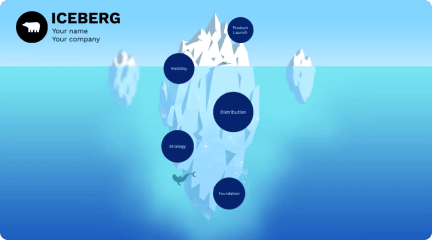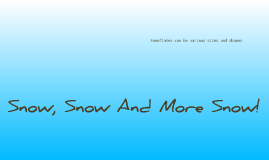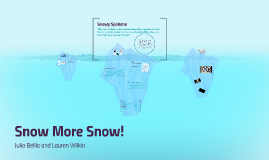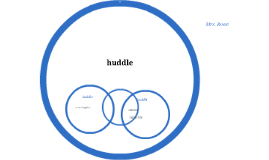Snow More Snow
Transcript: Dixie Cups (5) Filtered hot water (microwaved to 180 degrees) Filtered cold water (refrigerated to 40 degrees) 2 tsp of salt 2 tsp of sugar Ruler Microwave Freezer Sharpie Thermometer Our campus uses a rock salt from Salt Depot called "Ice Heat" It is "environmentally friendly" and "not harmful to vegetation" as stated on the bag. We have used a lot of it this season and you have probably seen the remnants of it across campus. When we pour too much of it down, not all the crystals are used and little blue granules remain on the sidewalks. Average snowfall in Spokane over last 30 years = 44.9 inches This year = 60.6 inches Our snowfall this year beat the snowfall levels in Buffalo, New York and Boston, Massachusetts and Minneapolis, Minnesota. Accelerates freeze-and-thaw cycles Damages concrete Corrodes metal harming automobiles and house siding Damages plants in surrounding area Run off from sidewalks gets into nearby bodies of water and increases salinity This year we have witnessed an incredible amount of snow. Since early November we have watched it fall for days at a time. But now we want it gone! Acid Blue Liquid Colorant Blend Controlled Variables: Water level in millimeters Question 1% Magnesium Chloride How Does This Relate to Campus and the Spokane Area? Which of these substances—hot water, cold water, salt or sugar—melts ice the fastest? Graphed Results Water is a better heat-conductor than air. We see this occur all the time. Snow falls and makes ice and then rain can come later in the day and melt the snow. This is because the molecules in water are more dense than the molecules in the air. It allows more contact with the ice and a faster rate of heat transfer. Additionally, water has a higher heat capacity than air. Snow More Snow! Snowy Spokane room temperature (73ºF) lack of sunlight same size and shape of ice cubes (3oz.) use of filtered water ice cubes frozen at same temp for the same duration (10ºF for 24 hours) duration between measurements (10 minutes) water level was measured in millimeters for each This is the rock salt that Gonzaga uses around campus. Especially this winter, we see it everywhere. Most buildings have a bag of this just inside the door. This is mostly sodium chloride which can run off of our sidewalks into the grass, gardens and even into Lake Arthur and the Spokane River. Our results conclude, the most effective substances to melt ice occur in the following order from most to least effective melting rate: Cold water, hot water, salt, sugar, then no variable application. De-icing On Campus Time in minutes 97% Sodium Chloride Our Conclusion Hypothesis Salt and sugar interrupt the ice making process. Salt is made up of one sodium ion and one chloride ion. These split apart and bind to the hydrogen and oxygen that make up water. Due to the extra ions binding, the water can’t pack as densely. This lowers the temperature at which the water can freeze. Sugar works in a similar way, but with carbon, hydrogen and oxygen molecules. Sugar lowers freezing temperature, but not to the same level as salt. Materials: Dependent Variable Time Lapse of Sugar How do salt and sugar melt ice? The hot water will melt the ice cube the fastest. Harmful Effects of De-Icer This experiment looks at the different substances used to melt snow. Specifically, we tested hot water, cold water, salt and sugar to see which substance would melt ice the quickest. Time Lapse of Melting Time Lapse of Salt 1% Calcium Chloride Raw Data 1% Potassium Independent Variable Julia Bellia and Lauren Wilkin How does water melt ice? Sodium Chloride (NaCl) makes its way inot the soil, onto vegetation and into ground water. It is toxic to aquatic life and can't be naturally broken down, metabolized, absorbed or removed from the environment.

















